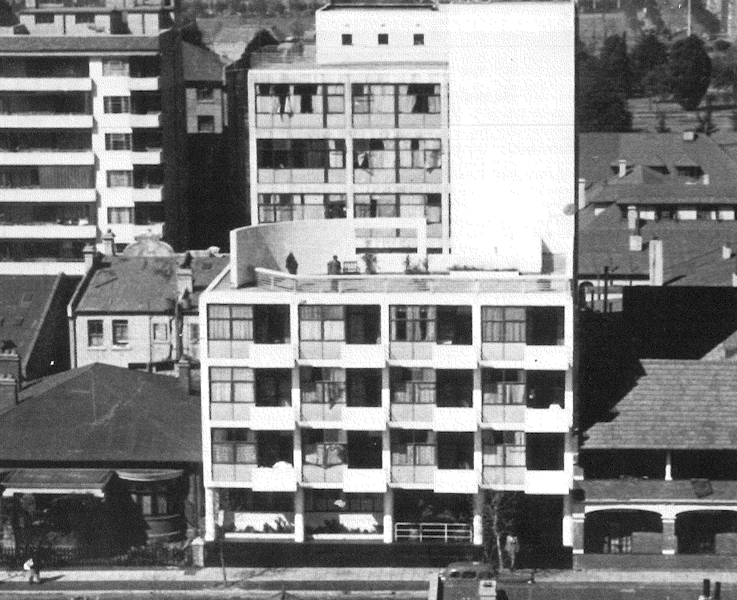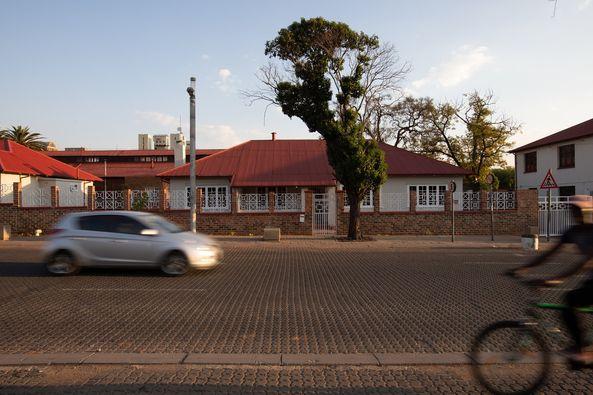The Herbert Prins Colloseum Awards is an iconic Johannesburg heritage award that has been reinvigorated and is now hosted by the Gauteng Institute for Architecture. At the recently held awards ceremony two restoration projects undertaken by Johannesburg architectural and conservation practice, Mayat Hart Architects, received recognition. The two projects which had a fraction of the budget of many of the other projects recognised show how, with good professional guidance, an award winning and high quality restoration can be achieved on a tight budget. They are models for how heritage resources can be protected and used in a constructive, socially and financially sustainable way.
The first project is the Restoration of Aiton Court for Trafalgar Property Management. Completed in 1937, Aiton Court is an early International Style modernist apartment block located in Hillbrow, Johannesburg. The building was designed by pioneering Wits graduates Angus Stewart and Bernard Cooke. With an efficient design consisting of two blocks of bachelor apartment and single rooms, it was both internationally recognised and lauded when it was built. Beyond its architectural significance, the building become socially significance. In the 1980’s, when owned by the Rawat Family, it was one of the first buildings to break apartheid segregation laws by welcoming black residents, with the building becoming a base for political activities as well as a hiding place for political operatives. It was during this period that a mosque opened in two of the ground floor courtyard facing apartments, a feature of the building which has been retained. After attempts to have the building restored by local architects such as Prof Hannah Le Roux, it fell into disrepair and was eventually high jacked. The buildings new owners wanted to renovate it as low cost housing meaning that the restoration work had to be done on a low budget with conservation needs having to be balanced with commercial realities. This was used to work in the interest of conservation with the repair, restoration and reuse of original fabric favoured over replacement with skilled and semi-skilled local contractors used for the labour intensive work. Priority was given to the restoration of public spaces which add greater value to the residents. Before repair and restoration started, the building was used as a tool for teaching architectural conservation and documented by architecture students from the University of the Witwatersrand. Despite limited budget the work aimed to respect and recognize both the buildings architectural and cultural significance.
Old photo of Aiton Court
The second project is the restoration of the Workers Museum Cottages for the City of Johannesburg. Dating from the early 20th century, the Workers Cottages in Newtown, Johannesburg, form part of the Workers Museum Complex. The Workers Museum is located in a former black migrant workers’ hostel, with the adjacent cottages built for white staff and supervisors. The museum speaks of the harsh segregated labour practices in the city with the relative comfort of the adjacent cottages further highlighting the segregation and prejudice that existed between workers of different races. The cottages, facing onto Mary Fitzgerald Square, had fallen into a state of disrepair and were left crumbling and unusable after a failed renovation project in the mid 2000’s.
The project aimed to bring the cottages back to a condition where they could be used for offices for the Museum as well as spaces for various tenants and NGO’s that support arts, culture and heritage. From the beginning, a tight budget was used as a means to conceptually guide the project.Botched renovations and the stripping out of sections of the building were seen as an opportunity to reveal the underlying materiality of the building. The building was seen as a physical documentation of its own history with its original materiality, defects and quirks accepted as part of its character and significance.
The intention of the project was always to bring back the original quality of the building and not have new interventions outshine the old. With this in mind the hand of the architect had to be kept very light, almost invisible. The existing buildings guided design decisions with only a slight reinterpretation necessary to show these as a contemporary layering onto the site. Original paint colours of ochre and turquoise uncovered during the restoration were reinterpreted as blocks of colour to bring new energy into the spaces while new fittings and finishes are all reinterpretations of the old.
Wherever possible existing materials were reused and recycled, from windows and floor boards to bollards and recovered bricks. Artwork became an important part of the project. A call was put out for local artists to prepare artworks following the theme of “Labour and Johannesburg - reflecting the past and present of workers in the region”. From the proposals 50 artists were commissioned to produce small artworks to form a permanent collection in the buildings. Framed and displayed in the recovered and recycled windows frames from the building they add an important new energy and meaning to the restored spaces. The commissions for the artists, in the midst of the COVID pandemic, were widely welcomed with the MMC for Community Development, Cllr Arnolds, expressing this at the opening of the buildings saying that “the artworks speak widely and directly to the people. They tell the stories of our City and of our nation; of our heroes and of the ordinary people. In that way, we are able to connect to workers’ history and this helps to show who we are and how we connect to our past and to each other. It is very fitting that these art works should be shown here.”
The success of the renovation and restoration is a pair of buildings that look like they belong, as if nothing has changed despite their substantial upgrade. While the buildings represent a difficult part of South Africa and Johannesburg’s past their preservation is important. With the adjacent museum, the buildings remind us of a segregated and brutal past. They also however act as a reminder of how far we have come and are a symbol of hope for what can be achieved.
Newtown Workers Houses
The process of restoration undertaken for both projects is probably best described as sitting somewhere between repair and restoration. It is an approach to heritage architecture and conservation that is cognisant of the local financial and social conditions creating a new locally appropriate benchmark. It is an approach that wants to address the perception that heritage and conservation is a burden and balance it with the creation of building that protect their heritage value through their continued use.
For more information visit www.mayathart.com or email info@mayathart.com.
Disclaimer: Any views expressed by individuals and organisations are their own and do not in any way represent the views of The Heritage Portal.


